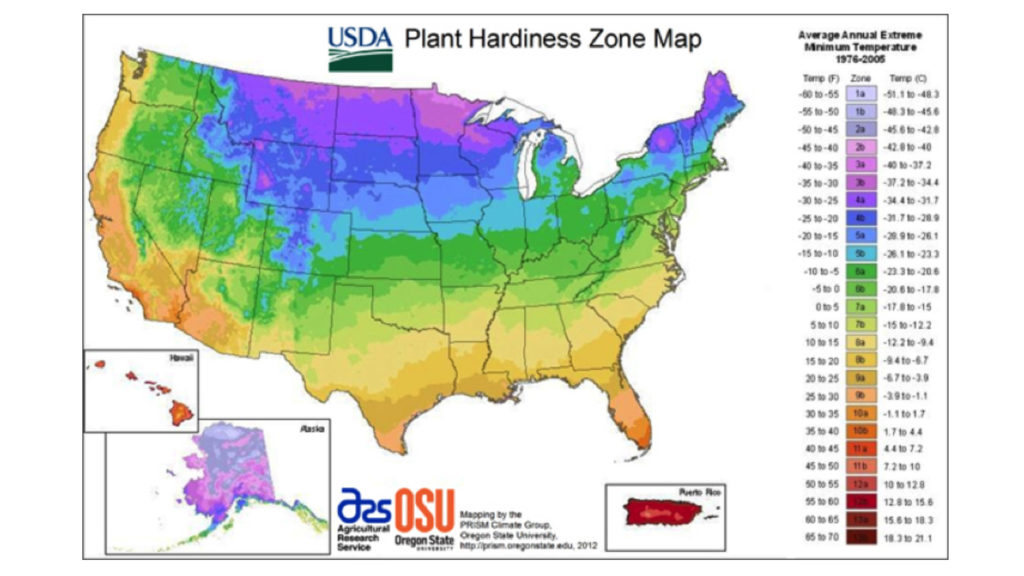Most of the wildflowers and grasses sold by Garrett Wildflower Seed Farm can be grown in many areas of the United States. The Plant Hardiness Zone Map will assist in your success by showing the right time to plant for your zone. Information for proper planting times is included in the planting recommendations section for each variety.
To learn more about plant hardiness zones, visit the U.S. Department of Agriculture’s website to use their interactive GIS-based map. The 2012 USDA Plant Hardiness Zone Map is the standard by which gardeners and growers can determine which plants are most likely to thrive at a location. The map is based on the average annual minimum winter temperature, divided into 10-degree F zones.
More Map & Gardening Information from the U.S. Department of Agriculture
If your hardiness zone has changed in this edition of the USDA Plant Hardiness Zone Map (PHZM), it does not mean you should start pulling plants out of your garden or change what you are growing. What is thriving in your yard will most likely continue to thrive.
Hardiness zones are based on the average annual extreme minimum temperature during a 30-year period in the past, not the lowest temperature that has ever occurred in the past or might occur in the future. Gardeners should keep that in mind when selecting plants, especially if they choose to “push” their hardiness zone by growing plants not rated for their zone. In addition, although this edition of the USDA PHZM is drawn in the most detailed scale to date, there might still be microclimates that are too small to show up on the map.
Microclimates, which are fine-scale climate variations, can be small heat islands—such as those caused by blacktop and concrete—or cool spots caused by small hills and valleys. Individual gardens also may have very localized microclimates. Your entire yard could be somewhat warmer or cooler than the surrounding area because it is sheltered or exposed. You also could have pockets within your garden that are warmer or cooler than the general zone for your area or for the rest of your yard, such as a sheltered area in front of a south-facing wall or a low spot where cold air pools first. No hardiness zone map can take the place of the detailed knowledge that gardeners pick up about their own gardens through hands-on experience.
Many species of plants gradually acquire cold hardiness in the fall when they experience shorter days and cooler temperatures. This hardiness is normally lost gradually in late winter as temperatures warm and days become longer. A bout of extremely cold weather early in the fall may injure plants even though the temperatures may not reach the average lowest temperature for your zone. Similarly, exceptionally warm weather in midwinter followed by a sharp change to seasonably cold weather may cause injury to plants as well. Such factors are not taken into account in the USDA Plant Hardiness Zone Map.
All PHZMs are just guides. They are based on the average lowest temperatures, not the lowest ever. Growing plants at the extreme of the coldest zone where they are adapted means that they could experience a year with a rare, extreme cold snap that lasts just a day or two, and plants that have thrived happily for several years could be lost. Gardeners need to keep that in mind and understand that past weather records cannot be a guarantee for future variation in weather.
Other Factors
Many other environmental factors, in addition to hardiness zones, contribute to the success or failure of plants. Wind, soil type, soil moisture, humidity, pollution, snow, and winter sunshine can greatly affect the survival of plants. The way plants are placed in the landscape, how they are planted, and their size and health might also influence their survival.
- Light: To thrive, plants need to be planted where they will receive the proper amount of light. For example, plants that require partial shade that are at the limits of hardiness in your area might be injured by too much sun during the winter because it might cause rapid changes in the plant’s temperature.
- Soil moisture: Plants have different requirements for soil moisture, and this might vary seasonally. Plants that might otherwise be hardy in your zone might be injured if soil moisture is too low in late autumn and they enter dormancy while suffering moisture stress.
- Temperature: Plants grow best within a range of optimum temperatures, both cold and hot. That range may be wide for some varieties and species but narrow for others.
- Duration of exposure to cold: Many plants that can survive a short period of exposure to cold may not tolerate longer periods of cold weather.
- Humidity: High relative humidity limits cold damage by reducing moisture loss from leaves, branches, and buds. Cold injury can be more severe if the humidity is low, especially for evergreens.

